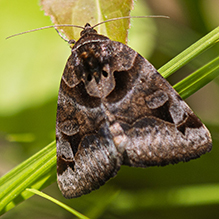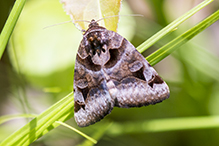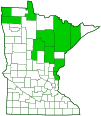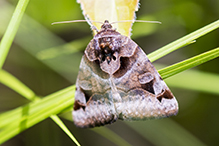toothed somberwing
(Euclidia cuspidea)
Conservation • Description • Habitat • Ecology • Distribution • Taxonomy
|
|
|||||||||||||||||
Description |
Toothed somberwing is a stout, medium-sized moth. The adult is about ⅞″ long and has a wingspan of 1⅛″ to 1 7 ⁄16″. The forewing is mottled dark brown and purplish-gray with dark, blackish-brown markings. The markings include an antemedian band with a prominent triangular tooth on the lower (proximal) side; an inconspicuous, zig-zag, postmedian line; a prominent triangle below (distal to) the reniform spot; and a subapical spot at the margin that connects to a small triangle. Some individuals have a broad pale submarginal band. Two blackish-brown spots surrounded by gray in the basal area near the inner margin lend to the appearance of a face. The hindwing is dark brown from the base to the median area. It is yellowish-brown from the median area to the margin except for a dark submarginal line. The hindwings and forewings are held in contact by bristles (a frenulum) and scales (a retinaculum). The antennae are slender and threadlike, not feathered. The caterpillar is slender, brown and finely striped. A thin brown spiracular stripe is bordered on each side by a thin pale stripe. There are no leg-like structures (prolegs) on abdominal segment 3 but there are reduced prolegs on segment 4. |
Size |
Wingspan: 1⅛″ to 1 7 ⁄16″ Total length: about ⅞″ |
Similar Species |
Habitat |
Meadows, woodland edges and openings, with long grass |
Ecology |
Season |
Probably one generation in Minnesota: Mid-May to early July |
Behavior |
It is active both day and night. When flushed from vegetation it flies rapidly for about 20 yards then drops to the ground. It rests with the wings held flat and the hindwings usually concealed. It is attracted to light. |
Life Cycle |
Pupa overwinter |
Larva Hosts |
Clover, lupine, sweetfern, and grasses |
Adult Food |
|
Distribution |
||
|
Sources 7, 21, 29, 30, 71, 75, 82, 83. Biodiversity occurrence data published by: Minnesota Biodiversity Atlas (accessed through the Minnesota Biodiversity Atlas Portal, bellatlas.umn.edu, 8/15/2025). |
|
| 8/15/2025 | ||
Occurrence |
||
Common and widespread |
||
Taxonomy |
|
Order |
|
Superfamily |
Noctuoidea (Owlet Moths and Allies) |
Family |
Erebidae (Underwing, Tiger, Tussock, and Allied Moths) |
Subfamily |
Erebinae (underwings, zales, and related owlets) |
Tribe |
Euclidiini |
Genus |
Euclidia |
Subordinate Taxa |
|
|
|
Synonyms |
|
|
|
Common Names |
|
toothed somberwing toothed somberwing moth |
|
Glossary
frenulum
A spine (male) or multiple spines (female) at the base of the costal edge of the hindwing of many moths that couples with the retinaculum on the forewing to keep the wings in contact which each other.
Reniform spot
A kidney-shaped spot or outline in the lower median area near the PM line on the forewing of many moths.
Visitor Photos |
||
Share your photo of this insect. |
||
This button not working for you? |
||
|
||
MinnesotaSeasons.com Photos |
||
 |
||
|
||
 |

Slideshows |
|

Visitor Videos |
||
Share your video of this insect. |
||
This button not working for you? |
||
|
Other Videos |
||
|

Visitor Sightings |
||
Report a sighting of this insect. |
||
This button not working for you? |
||
|
|
MinnesotaSeasons.com Sightings |
||

Created: 2/13/2016 Last Updated: © MinnesotaSeasons.com. All rights reserved. |

